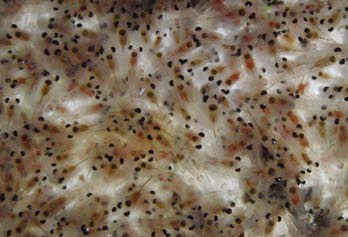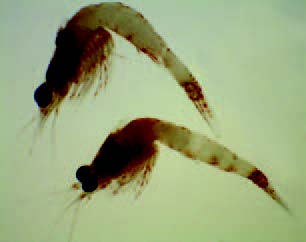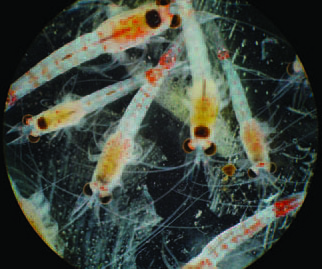Bloody red shrimp
Bloody red shrimp
Bloody red shrimp is an invasive crustacean native to freshwater areas of the Black, Azov and Caspian seas in eastern Europe and western Asia. It has been found in all of the Great Lakes except Lake Superior. The shrimp was likely introduced and spread through the Great Lakes by ballast water from ocean-going ships.
Bloody red shrimp travel in swarms that look like reddish clouds in the water. At night the shrimp move toward the surface of the water. By day they are difficult to see because they avoid direct sunlight, clustering on rocky lake bottoms or in protected areas near hard structures such as docks, piers and boats. They move quickly when disturbed.
Bloody red shrimp grow and multiply rapidly, and scientists have seen dense swarms of more than 500 shrimp per cubic metre in some locations. They eat the tiny plants and animals known as plankton, insect larvae, and each other.

Bodies are translucent with bright red to reddish-orange colouring. Photo: Tim Johnson, MNR
Range
The first Ontario sighting of bloody red shrimp was in 2006 in Lake Ontario at Pickering. Later that year the shrimp was found in Lake Ontario near Oswego, New York, and in Lake Michigan near Muskegon, Michigan. It was likely introduced to the Great Lakes earlier, but not found because it hides in protected areas and moves too fast to be caught in traditional nets.
Since 2006, more swarms of bloody red shrimp have been found in other areas of Lake Ontario and in lakes Erie, Michigan and Huron. The shrimp is also established in some inland lakes in the United States, the United Kingdom, and across Europe to the Baltic Sea. Its native range is similar to that of zebra mussels and several other invaders that have been introduced to North America.
Possible impacts of bloody red shrimp
Scientists don’t fully understand the impact of the bloody red shrimp on the Great Lakes, but believe its eating habits and ability to multiply rapidly could threaten native species.

Male and female bloody red shrimp. Photo: Tim Johnson, MNR
- By eating large quantities of the tiny animals called zooplankton, the shrimp could reduce the food available for the young of native fish.
- Reducing the supply of zooplankton could have far- reaching effects on the normal food chain of native species.
- Dense swarms of bloody red shrimp could compete with native fish for food and resources.
How to identify bloody red shrimp
- Female bloody red shrimp are up to 1.7 centimetres long, while males are up to one centimetre long.
- Bodies are translucent with bright red to reddish-orange colouring, especially around the head and tail. The colour varies depending on light and temperature.
- The shrimp are most often seen during the day in shaded waters as reddish swarms of tiny animals.
- Eyes are large and black, and extend from the body on short stalks.
- The tail is square with two spines at the end.
Similar species
The native opossum shrimp (Mysis diluviana, formerly known as M. relicta) is very similar, but when seen under a magnifying glass the opossum shrimp’s tail is forked, while the bloody red shrimp’s tail is square with two spines at the end.

Swarm of bloody red shrimp. Photo: NOAA Great Lakes Environmental Research Lab

Large black eyes extend from the body on short stalks. Photo: NOAA Great Lakes Environmental Research Lab
What you can do
- Learn how to identify bloody red shrimp and how to prevent accidentally spreading this invasive species.
- Inspect your boat, trailer and equipment after each use.
- Remove all plants, animals and mud before moving to a new waterbody.
- Drain water from the motor, live well, bilge and transom wells while on land.
- Rinse all recreational equipment with high pressure (>250 psi) or hot (50°C /122°F) water or let it dry in the sun for at least five days.
- Don’t put live shellfish into Ontario waters.
- If you’ve seen a bloody red shrimp or other invasive species in the wild, please contact the toll-free Invading Species Hotline at
1-800-563-7711 , or visit Ontario’s invading species awareness program to report a sighting.
Other resources:
For more information:
Please contact the Invading Species Hotline at
This fact sheet may be reproduced for non-commercial purposes. © 2012
Cette publication est également disponible en français.

Cluster of bloody red shrimp. Photo: NOAA Great Lakes Environmental Research Lab